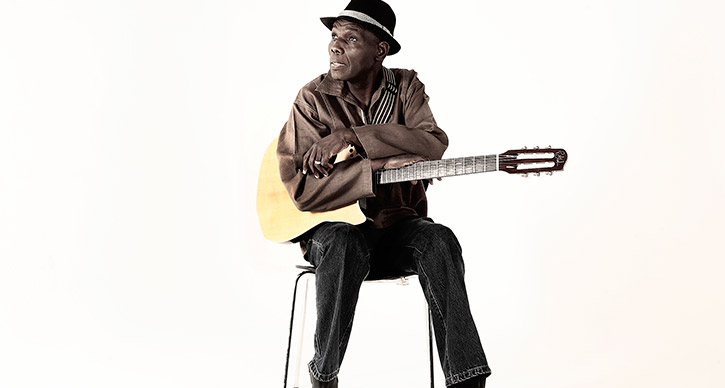UMS Playlist: Social Change and African Popular Music
This post is a part of a series of playlists curated by UMS staff, artists, and community. Check out more music here.

Oliver Mtukudzi. Photo courtesy of the artist.
Zimbabwe’s Afropop legend Oliver Mtukudzi performs in Ann Arbor on April 17, 2015.
“Tuku” has created 61 solo albums to date, many of which focus on political and social themes. His band The Black Spirits got its start performing songs protesting the white colonial rule of Zimbabwe in the 1960s and 70s.
Throughout his career, Tuku has refrained from direct political criticism, instead using metaphor to communicate his ideas: “The beauty of the Shona language is that it is endowed with all those rich idioms and metaphor…and the beauty of art is that you can use the power of language to craft particular meaning without necessarily giving it away. So, I used the beauty of Shona to communicate in my own way and people got the message.”
Themes of social change are common in popular African music. In this listening guide, explore some of the history of this connection.
1. Nelson Mandela commissioned the group “Sipho Hotstix Mabuse” to write a campaign theme song for his bid to be South Africa’s first democratically elected president in 1994. Simply titled “Nelson Mandela,” the song speaks frankly about the Mandela’s hopes to promote unity in the country.
2. Angelique Kidjo (who last performed in Ann Arbor in 2013) blends musical traditions from her native Benin with Western popular music, singing in English as well as her childhood languages of Fon and Yoruba. Many of her songs include themes of peace, tolerance, and liberation. In “Kulumbu,” Kidjo speaks about the nececsity for women to participate in conflict resolution after suffering disproportionately during war.
3. The title of Bassekou Kouyate’s song “Jama Ko” translates to “the gathering,” and urges for peace and reconciliation in Mali. Bassekou Kouyate last performed in Ann Arbor as part of our 2013-2014 season.
4. Tuku’s song “Wasakara” describes the corruption and violence of the government of Zimbabwean president Robert Mugabe. He sings, “Admit it, you are wrinkled/You are worn out.”
5. Thomas Mampfuno also criticizes the government in “Mamvemve,” with the lyrics “the country you used to cry for is now in tatters.” Zimbabwe’s political environment is so restrictive that Mampfuno has not visited the country since 2004.
6. In “Ndakuvara,” Mugabe is represented by an ox too stubborn to learn from its elders. Through metaphor, Tuku writes protest as subtext subtle enough to allow him to remain in Zimbabwe.
What did you think about this playlist? What songs would you add?
Educator Conversations: One Night in Bamako
Editor’s note: This post is a part of a series of conversations between educators in the K-12 community. Educators will offer suggestions and answer questions about integrating UMS School Day Performances or the arts into classroom curriculum, as well as share advice on organizing a field trip to UMS. To volunteer to be a Teacher Lobby Moderator e-mail umsyouth@umich.edu. Or, check out other Educator Conversations.
This week’s questions:
- Who are these two artists, Bassekou Kouyaté and Ngoni Ba?
- How should I prepare my class for the performance?
- Bamako? What? Where? And who cares?
- Isn’t taking a class on a field trip too much trouble?
 This week’s moderator: Jeff Gaynor. Jeff has been teaching for 35+ years, 20 years at Elementary, and the last 15+ at Clague Middle School, where he teaches Math and Social Studies. He integrates music and art into the curriculum, often prior to field trips, or by bringing guest artists in his classroom. Jeff is on the UMS Teacher Insight Committee has an interest in classical, jazz and world music. He has participated in month-long teacher study trips to Belize, Turkey and South Africa.
This week’s moderator: Jeff Gaynor. Jeff has been teaching for 35+ years, 20 years at Elementary, and the last 15+ at Clague Middle School, where he teaches Math and Social Studies. He integrates music and art into the curriculum, often prior to field trips, or by bringing guest artists in his classroom. Jeff is on the UMS Teacher Insight Committee has an interest in classical, jazz and world music. He has participated in month-long teacher study trips to Belize, Turkey and South Africa.
Q: Who are these two artists: Bassekou Kouyaté and Ngoni Ba?
Ha – this was my first question – and I can save you the same embarrassment. Bassekou Kouyaté is the lead musician. He plays an ancient traditional stringed instrument, like a lute, but he has also modernized it in amazing ways. This instrument is called the ‘ngoni.’ “Ngoni Ba” is the name of the band he leads. Check them out.
Q: How should I prepare my class for the performance?
It’s important that students look forward to the trip with anticipation. The level of academic preparation depends on the grade, subject, and how much time you can spend (pressing issue, I know). At a minimum, I go through the UMS Learning Guide and choose 1 or 2 activities to do with my students. Also very helpful, especially with unusual instruments or genres, is to play audio or video clips in class, and have a discussion to focus attention on how this music is alike or different from other music they have heard.
You can find videos on YouTube, and the Guide has more suggestions. Seeing or listening to the music in your classroom isn’t the real thing, though curiously, the appreciation for the live performance will be increased if students have seen the performer before hand, if on a screen. At a minimum go to the UMS web page and click on “Listen & Learn.”
Of course, the more curriculum connections you make, the more students will take out of the live performance, which leads us to:
Q: Bamako? What? Where? And who cares?
“‘I mean, what is music itself? Music is everywhere, every day. If you’re gonna genuinely do that, you prohibit all sound because music is in language, it’s in everything. It’s totally abhorrent to any musician to be told they can’t play music… It’s a very particular interpretation of the Koran that prohibits all music,’ said Damon Albarn, an Africa Express co-founder.”
Quote from BBC News.
And suddenly, music is more than just music. And Bamako, the capital of Mali, in the horn of Africa, is more than some far away place. And we are teachers – it is our job to show the commonalities and the uniqueness of people in all parts of the globe.
Explore geography – with a map of West Africa, and a map of Mali, point out the the capital of Bamako, the fabled city of Timbuktu (Tombouctou), the Niger River, and the seven countries that border Mali. Find images of these places.
Read folk tales from Mali (or West Africa) as folk tales are universal and also particular. Point out that Bassekou Kouyaté is a griot – a historian and storyteller, through his music.
Most of the northern tier of Africa is heavily Muslim, as is Mali. This is part of their culture and influences the music. Islam is one of the five world religions covered in the Ann Arbor middle school social studies curriculum and may be integrated during the study of Islam or the Middle East or Northern Africa.
The quote that led this section was in response to a crisis in Mali during which Islamic fundamentalists took control of the northern part of the country. France (Mali was a French colony until 1960) then intervened militarily. This is a vital area for research with parallels and ramifications throughout the region.
Q: Isn’t taking a class on a field trip too much trouble?
No! It does take preparation but the benefits far outweigh the effort. And it will be an experience your students will remember for years and link to their classroom learning.
As an elementary teacher, and now middle school social studies teacher, I feel it is eminently important to help students link classroom experiences to the world around them. Reading about a country, or culture, or listening to a CD is one thing; attending a live concert is a visceral experience that brings learning to another level. This music may be different, but music is universal.
UMS keeps the cost of their School Day performances low. As I teach in Ann Arbor, I also choose to have my students travel on the City Bus – a $1.50 round trip, with the benefit that they get more real life experiences. I ask parents to pay the cost (under $10) or what they can, and the School PTSO makes up the difference.
Check out the AATA website for route maps and schedules. You do not need to contact them ahead of time. Do have students go to the back of the bus while you pay the driver for everyone. Do not have each student pay his or her own fare as it takes much too long.
I prepare my class not only for the concert but for taking the bus and walking through city streets: how to wait for and behave on the bus, how to leave space on the sidewalk to allow other pedestrians to pass, how to cross the street – all real life skills that they take seriously. They understand they are now off school property and the expectations are obligatory, not arbitrary. Of course I also prepare them to be good audience members, referring to the UMS Learning Guide for valuable reminders.
In fact the Learning Guide has important and worthwhile resources for pre- and post-concert links, resources and activities. Do take the time to read through it.
Do you have questions or comments for Jeff about his approach to this performance or about teaching through performance more broadly? Share your responses or questions in the comments section below.


